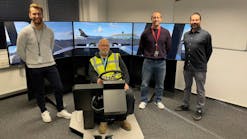How Training Programs Mitigate Ramp Safety Risks
Ramp safety risks associated with extreme weather phenomena need to be addressed as training items within aircraft ground handling companies.
Indeed, personnel training is a critical component to addressing and mitigating ramp safety risks related to severe weather conditions, according to Aleksis Kajava, Vaisala sales director of weather and environment for Europe and Latin America.
“Training programs should educate staff about different types of severe weather so they can assess risks, use weather monitoring tools and software to respond to specific weather events, and ultimately prioritize the well-being of airport staff and passengers,” he says.
Above all, training should contain an awareness of the risks of working in adverse weather, according to Libor Kurzweil, director of quality, safety, and process management at Prague Airport.
“Everyone should be able to encode what is threatening them in a thunderstorm. This is above all because life is at stake here. Strong winds cannot be underestimated either,” he says.
At Menzies Aviation, all employees are provided severe weather training, from choking requirements and how to secure unit loading devices (ULD) safely and efficiently, to the operation of aircraft cargo doors, passenger aircraft decks and passenger safety, affirms Alan Glen, senior vice president of group risk at Menzies Aviation.
“There is also support from dedicated training programs provided by airport partners, tailored to the types of adverse weather conditions identified as high risk for their specific location or region. Each airport, country and region is different and may face different environmental weather conditions, so it is important to adapt and customize the appropriate training procedures,” he says.
dnata ensures training and briefing to the employees as well as provision of personal protective equipment (PPE).
“We also ensure oversight and monitoring of staff with active supervision/intervention or coaching, guiding and mentoring where necessary (e.g., advising staff to drive with additional care due to surface conditions and monitoring during),” says David Storey, vice president for health and safety at dnata.
At Baltic Ground Services (BGS), personnel are trained in specific safety procedures designed for challenging weather scenarios, learning how to react to changes in weather conditions, take appropriate precautions, and follow emergency protocols, according to Dmitrij Kostojanskij, safety manager at BGS.
“Training includes proper management of ground support equipment, vehicles and instruments in adverse weather conditions and emphasizes clear and timely communication with colleagues, air traffic control, airlines and other stakeholders to ensure coordinated responses,” he says. “Personnel should be trained to respond quickly and effectively to emergencies, such as lightning, floods or accidents caused by slippery surfaces, and must have experience in evacuation procedures and how to aid during emergencies.”
Training courses should educate personnel on how to assess the risks associated with severe weather conditions, including understanding the likelihood and potential consequences of specific weather events, how to interpret weather data and forecasts, enabling them to make informed decisions about ramp operations and whether to interrupt or modify adverse weather activities in response to changing weather conditions, emphasizes Kostojanskij.
“Overall, personnel training is a critical component of ramp safety in adverse weather conditions. It enables people to make informed decisions, respond effectively to emergencies and contribute to a safety culture that prioritises the well-being of personnel and the protection of assets in challenging weather conditions. Training programmes create awareness of the potential risks of severe weather conditions and the importance of preparedness,” he concludes.







